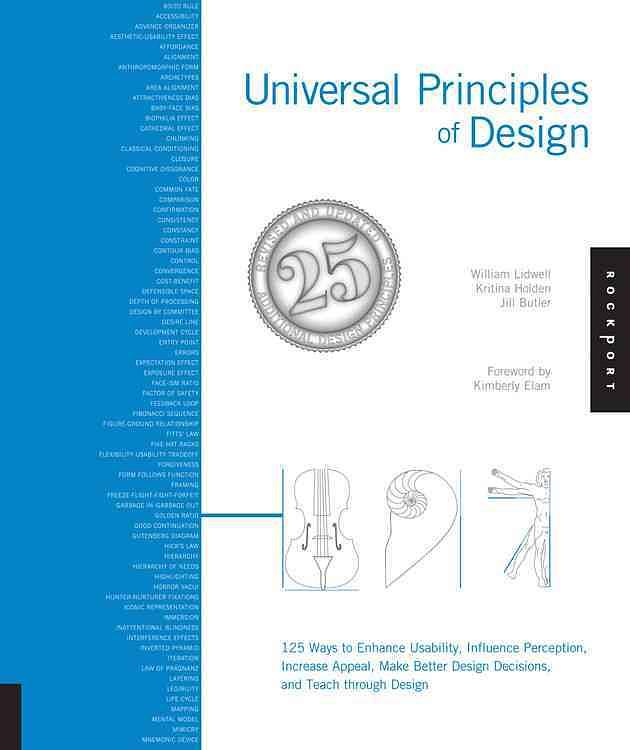內容簡介
內容簡介 The design we see - whether a marketing campaign or a museum exhibit, a video game or a complex control system - is the culmination of many concepts and practices brought together from 21 variety of disciplines. Because no one person can be a master of all of these disciplines, designers have had to search through different references and resources to find the information and know-how required to make a design work, until now.Universal Principles of Design is the first cross-disciplinary reference of design. Richly illustrated and easyto navigate, this book pairs clear explanations of the design concepts featured with visual examples of the concepts applied in practice. From the "80 20 Rule" to "Chunking," from "Baby-Face Bias" to "Ockham's Razor," and from "Self-Similarity" to "Storytelling," readers will expand their knowledge of 125 important and thought-provoking design concepts.This landmark reference has become the standard for designers, engineers, architects, and students who seek to broaden and improve their design expertise. This second edition includes revisions, updates, and twenty-five new principles. Universal Principles of Design, Revised and Updated is a comprehensive, cross-disciplinary encyclopedia covering 125 laws, guidelines, human biases, and general considerations important to successful design. Richly illustrated and easy to navigate, it pairs clear explanations of every design concept with visual examples of the ideas applied in practice. From the 80 20 Rule to the Weakest Link, every major design concept is defined and illustrated. Whether a marketing campaign or a museum exhibit, a video game or a complex control system, the design we see is the culmination of many concepts and practices brought together from a variety of disciplines. Because no one can be an expert on everything, designers have always had to scramble to find the information and know-how required to make a design work—until now. Just a few of the principles that will broaden your design knowledge, promote brainstorming, and help you check the quality of your work:Baby-Face BiasExpectation EffectGolden RationOckham's RazorProximityScaling FallacyThe book is organized alphabetically so that principles can be easily and quickly referenced by name. For those interested in addressing a specific problem of design, the principles havealso been indexed by questions commonly confronting designers (How can I help people learn from my design? How can I enhance the usability of a design? How can I make better design decisions? ...). Each principle is presented in a two-page format. The left-hand page contains a succinct definition, a full description of the principle, examples of its use, and guidelines for use. Side notes appear to the right of the text, and provide elaborations and references. The right-hand page contains visual examples and related graphics to support a deeper understanding of the principle. This landmark reference is the standard for designers, engineers, architects, and students who seek to broaden and improve their design expertise. Whether a marketing campaign or a museum exhibit, a video game or a complex control system, the design we see is the culmination of many concepts and practices brought together from a variety of disciplines. Because no one can be an expert on everything, designers have always had to scramble to find the information and know-how required to make a design work�until now.Universal Principles of Design, Revised and Updated is a comprehensive, cross-disciplinary encyclopedia of design. Richly illustrated and easy to navigate, it pairs clear explanations of every design concept with visual examples of the concepts applied in practice. From the "80 20� rule to chunking, from baby-face bias to Occam's razor, and from self-similarity to storytelling, every major design concept is defined and illustrated for readers to expand their knowledge.This landmark reference will become the standard for designers, engineers, architects, and students who seek to broaden and improve their design expertise.
作者介紹
作者介紹 William Lidwell is the Director of Design at Stuff Creators Design in Houston, Texas. He is author of the best-selling design book, Universal Principles of Design, which has been translated into 12+ languages, and Deconstructing Product Design, a social deconstruction of 100 classic products. He is the lecturer of two video series on design: ""How Colors Affect You: What Science Reveals"" available from The Great Courses, and ""The Science of Logo Design,"" available from Lynda.com.Kritina Holden is a Human Factors specialist at Lockheed Martin–Space Operations and NASA, where she is responsible for performing applied research on HCI topics for the space environment. Formerly a Lead Usability Engineer with BMC Software, Kritina is author of numerous guideline texts in the areas of human-computer interaction and human performance.Jill Butler is the founder and president of Stuff Creators Design Studio. She and her staff help clients explain concepts and express themselves through graphics, interaction design, web site design, printed products, and custom-designed 3-D objects. She has worked as a print designer, information designer, and multimedia designer for herself and various companies in the Houston area. Jill served as a lecturer and taught design-related classes at the University of Houston and Kingwood Community College.William Lidwell is the Director of Design at Stuff Creators Design in Houston, Texas. He is author of the best-selling design book,Universal Principles of Design, which has been translated into 12+ languages; Deconstructing Product Design, a social deconstruction of 100 classic products; and lecturer of two video series on design: "How Colors Affect You: What Science Reveals" available from The Great Courses, and "The Science of Logo Design" available from Lynda.com.William Lidwell writes, speaks, and consults on topics of design and engineering. He is the author of multiple books including the best-selling design book Universal Principles of Design, which has been translated into 16 languages. He lives in Houston, TX.William Lidwell writes, speaks, and consults on topics of design and engineering. He is the author of multiple books including the best-selling design book Universal Principles of Design, which has been translated into 16 languages. He lives in Houston, TX.
